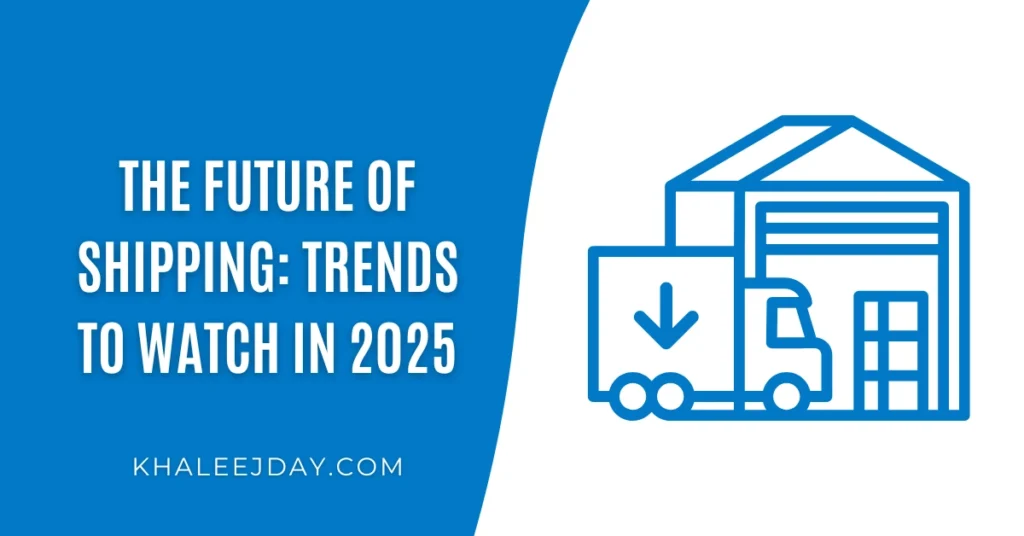The Future of Shipping: Trends to Watch in 2025
Heraclitus, one of the famous Greek philosophers, said, “There is nothing permanent except change.” Today, this statement is more true than ever. Everything changes with time. Especially since COVID-19, the evolution has only accelerated. Industries like education, healthcare, hospitality, and many more have been adopting technologies that were unheard of just five or ten years back.
The shipping industry is no exception. The global shipping sector moves over 11 billion tons of goods each year and generates more than $14 trillion in trade value. When an industry is this big, even the slightest changes can have a huge impact. Logistics are getting smarter with the use of AI, and with increased demand for cargo from Dubai to Russia and worldwide, 2025 shows us the trends we haven’t seen in previous years.

If you are in the shipping industry or curious about where the maritime trade industry is going, you need to read this article. We have highlighted some of the trends that will be seen in the industry in 2025 and the years ahead.
1. Digital Transformation and the use of AI
You can’t look past the digital transformation, whichever the industry is. The shipping industry has been seeing some of the digital revolutions that are reshaping how maritime trade and fleets are managed. In 2025, maritime companies have realized that they can’t ignore AI and its usage.
Every industry is using AI to make the process easier and more efficient. That’s what the shipping industry is heading ahead. So, what technologies has the shipping industry been adopting? There are many. Some of them include AI-powered route optimization, predictive maintenance, automated port operations, and digital twins.
Here is what these technologies are contributing to the maritime industry:
AI-driven route planning
- Helps vessels avoid congestion
- Reduces fuel consumption
- Cuts down transit times
- Analyzes real-time weather, ocean currents, and port data
Predictive maintenance with machine learning
- Anticipates machinery failures before they occur
- Reduces downtime
- Lowers repair costs
Smart ports with automation and IoT
- Enables faster cargo handling
- Supports real-time container tracking
Digital twins (virtual replicas of ships)
- Allow simulation of various operational scenarios
- Optimize performance, safety, and compliance
These are some of the technologies being adopted by many shipping companies and seaports. Wärtsilä is a Finland-based company that conducts maritime business surveys, revealing that 66% of shipping companies are on their digital journey, with 69% actively exploring digital solutions.
Many shipping companies in Dubai and seaports like Jebel Ali and Mina Rashid have already implemented many more advanced technologies to stay competitive in the fierce trade shipping world. These advancements reduce costs and increase safety for the shipping companies and the industry.
2. Decarbonization and Emissions Compliance
One of the complaints about the shipping industry is its negative role in the earth’s climate change. The industry produces a lot of carbon emissions. On average, the industry generates about 3% of global greenhouse gas emissions, releasing 1 billion metric tons of CO₂ annually. That is why many policies have been introduced over the years, and in 2025, the trends are focusing more on this aspect, too.
Maritime experts have highlighted three critical frameworks that will shape the industry in 2025: Regulations are CII (Carbon Intensity Indicator), EU ETS (Emissions Trading System), and FuelEU Maritime. What do these regulations talk about? Let’s have a loot.
CII (Carbon Intensity Indicator) – IMO
- Rates ships from A to E based on emissions per distance sailed.
- Introduced by the International Maritime Organization (IMO).
- Ships idle for long periods can get poor ratings, even if they aren’t polluting more.
EU ETS (Emissions Trading System)
- Shipping companies must buy carbon allowances based on their verified emissions.
- This process has been costly and complex to set up.
- Part of the EU’s effort to reduce emissions across industries, including shipping.
FuelEU Maritime
- Sets greenhouse gas limits on the fuel ships use.
- Companies now need to renegotiate charter party agreements to align with these rules.
- It also pushes companies to update their compliance policies for cleaner fuel use.
3. Trade Due Diligence is More Important Than Ever
Another aspect that has been much discussed in the shipping industry and will be the focus going ahead is trade due diligence. In 2025, shipping companies need to be extra careful about who they do business with. Why is that important? It has been brought up mainly due to the political situation worldwide and changing global sanctions.
There’s more pressure now to understand who owns the ships, where the cargo comes from, and who the trading partners are. What has happened in the past is that now and then, you see new shipping companies coming up. No public information or documents about these companies are available. It makes it harder and slower to do proper background checks.
Additionally, another big problem is fake shipping documents. These are sometimes used to hide goods that are under sanctions or to secretly send items to countries where trade is restricted. Because of this, governments like the UK are putting in new rules to stop the re-export of sensitive items. That’s why the importance of trade due diligence has been increasing, and there is a big trend shift going ahead in the shipping industry.
4. Cybersecurity in Maritime Operations
No industry is safe from cyber threats, and the maritime industry is no exception. With fleet management software, navigation systems, and cargo tracking all moving online, the risk of cyberattacks is higher than ever.
A single ransomware or malware attack can shut down entire operations, delay shipments, or leak sensitive trade data. Shipping companies, port authorities, and logistics platforms are partnering with cybersecurity firms, hiring in-house cyber defense teams, and training staff to detect and respond to suspicious activity.
Ports are also upgrading their digital layers, adding firewalls, intrusion detection systems, and encryption for data exchanges. Stronger protocols are also being used to secure real-time vessel monitoring and satellite communications. So, in 2025, one trend is to invest more in the cybersecurity network in the maritime industry.
5. Supply Chain Resilience and Diversification
The supply chain system in the shipping industry has been fragile for years. The COVID-19 pandemic, the Suez Canal blockage, and ongoing geopolitical tensions indicate the urgent need for change and innovation. In 2025, companies will no longer rely on a single-route approach for models. Instead, there’s a growing push towards building resilience in the supply chain.
What that means is the shipping industry and companies are diversifying sourcing and adding new transit corridors. They are considering nearshoring or reshoring options to reduce dependency on far-off regions.
Technology also plays a big role here. Digital supply chain platforms are helping companies get real-time visibility into where their cargo is, what routes are active, and where bottlenecks are forming. Ports are collaborating with logistics providers to ensure continuity even when traditional routes are blocked.
The Future of the Shipping Industry
In the end, the trends in the shipping industry are changing real fast. The 205 and upcoming years will bring new ideas and smart solutions to the industries. Companies are working hard to improve how they move goods, save energy, and stay safe from cyber threats. These new trends are helping shipping become more innovative, safer, and efficient. If you are part of this industry or just interested in it, now is the time to pay attention to what’s coming next. The future is exciting.




